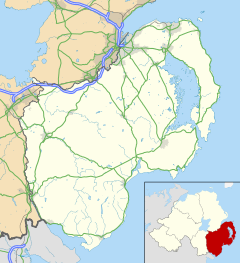Killough
Killough
|
|
|---|---|
| Killough shown within County Down | |
| Population | 845 (2001 Census) |
| District | |
| County | |
| Country | Northern Ireland |
| Sovereign state | United Kingdom |
| Post town | DOWNPATRICK |
| Postcode district | BT30 |
| Dialling code | 028 |
| EU Parliament | Northern Ireland |
| UK Parliament | |
| NI Assembly | |
Killough (/kᵻˈlɒx/ ki-LOKH; from Irish: Cill Locha, meaning "church of the loch") is a village and townland in County Down, Northern Ireland. It lies on the Irish Sea shore near Ardglass, five miles southeast of Downpatrick. It is notable for its sycamore-lined main street. In the 2001 Census it had a population of 845 people.
In the 17th century Ulster ports began to rise in prominence. In 1625 William Pitt was appointed as Customer of the ports of Newcastle, Dundrum, Killough, Portaferry, Donaghadee, Bangor and Holywood.
The village was originally known as St Anne's Port. The harbour was built in the 18th century by the Wards of Castle Ward house, just outside Strangford. A straight road still runs from Castle Ward to Killough. Killough was formerly in Rathmullan parish then transferred to Bright parish. The population in 1659 was 21. By 1821 it was 1,140 and in 1846 it was 1,148 with 224 houses, 51 families employed in agriculture; 126 in manufacturing or trade; 21 in professions; 118 in labouring jobs and 68 directing labour. In 1836 there was a Church of Ireland, two Methodist and a Catholic church. There were also some schools and an ancient well, St. Scordon's. The proprietor was Lord Bangor.
...
Wikipedia

